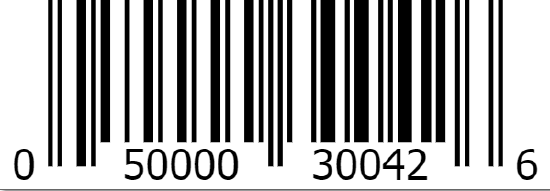3.6: Additional Exercises- Detecting Errors
- Page ID
- 81045
Universal Product Code (UPC) symbols are found on most products in grocery and retail stores. The UPC symbol is a 12-digit code identifying the manufacturer of a product and the product itself (Figure 3.32). The first 11 digits contain information about the product; the twelfth digit is used for error detection. If \(d_1 d_2 \cdots d_{12}\) is a valid UPC number, then
\[ 3 \cdot d_1 + 1 \cdot d_2 + 3 \cdot d_3 + \cdots + 3 \cdot d_{11} + 1 \cdot d_{12} \equiv 0 \pmod{10}\text{.} \nonumber \]
- Show that the UPC number 0-50000-30042-6, which appears in Figure 3.32, is a valid UPC number.
- Show that the number 0-50000-30043-6 is not a valid UPC number.
- Write a formula to calculate the check digit, \(d_{12}\text{,}\) in the UPC number.
- The UPC error detection scheme can detect most transposition errors; that is, it can determine if two digits have been interchanged. Show that the transposition error 0-05000-30042-6 is not detected. Find a transposition error that is detected. Can you find a general rule for the types of transposition errors that can be detected?
- Write a program that will determine whether or not a UPC number is valid.

Figure 3.32: A UPC code
It is often useful to use an inner product notation for this type of error detection scheme; hence, we will use the notion
\[ (d_1, d_2, \ldots, d_k ) \cdot (w_1, w_2, \ldots, w_k ) \equiv 0 \pmod{ n } \nonumber \]
to mean
\[ d_1 w_1 + d_2 w_2 + \cdots + d_k w_k \equiv 0 \pmod{ n}\text{.} \nonumber \]
Suppose that \((d_1, d_2, \ldots, d_k ) \cdot (w_1, w_2, \ldots, w_k ) \equiv 0 \pmod{ n}\) is an error detection scheme for the \(k\)-digit identification number \(d_1 d_2 \cdots d_k\text{,}\) where \(0 \leq d_i \lt n\text{.}\) Prove that all single-digit errors are detected if and only if \(\gcd( w_i, n ) = 1\) for \(1 \leq i \leq k\text{.}\)
Let \((d_1, d_2, \ldots, d_k ) \cdot (w_1, w_2, \ldots, w_k ) \equiv 0 \pmod{ n}\) be an error detection scheme for the \(k\)-digit identification number \(d_1 d_2 \cdots d_k\text{,}\) where \(0 \leq d_i \lt n\text{.}\) Prove that all transposition errors of two digits \(d_i\) and \(d_j\) are detected if and only if \(\gcd( w_i - w_j, n ) = 1\) for \(i\) and \(j\) between \(1\) and \(k\text{.}\)
Every book has an International Standard Book Number (ISBN) code. This is a 10-digit code indicating the book's publisher and title. The tenth digit is a check digit satisfying
\[ (d_1, d_2, \ldots, d_{10} ) \cdot (10, 9, \ldots, 1 ) \equiv 0 \pmod{11}\text{.}\nonumber \]
One problem is that \(d_{10}\) might have to be a 10 to make the inner product zero; in this case, 11 digits would be needed to make this scheme work. Therefore, the character X is used for the eleventh digit. So ISBN 3-540-96035-X is a valid ISBN code.
- Is ISBN 0-534-91500-0 a valid ISBN code? What about ISBN 0-534-91700-0 and ISBN 0-534-19500-0?
- Does this method detect all single-digit errors? What about all transposition errors?
- How many different ISBN codes are there?
- Write a computer program that will calculate the check digit for the first nine digits of an ISBN code.
- A publisher has houses in Germany and the United States. Its German prefix is 3-540. If its United States prefix will be 0-
abc, findabcsuch that the rest of the ISBN code will be the same for a book printed in Germany and in the United States. Under the ISBN coding method the first digit identifies the language; German is 3 and English is 0. The next group of numbers identifies the publisher, and the last group identifies the specific book.


